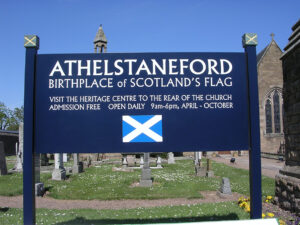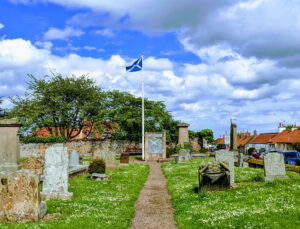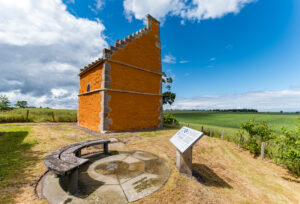MORE FROM SCOTLAND MAGAZINE
The Saltire Flag: History and legacy
As Scotland’s Flag Heritage Centre reopens after major restoration, we uncover the fascinating history of Scotland’s national symbol and the meaning behind it
The history of the Saltire Flag
It’s hard to think of Scotland without an image of the white Saltire cross against a blue background fluttering into your head. The oldest flag in Europe and the Commonwealth, the Saltire, or St Andrew’s Cross, is a symbol of Scotland and everything it stands for; its history is one of courage, valour, hope and reward – is there anything more Scottish?
The Saltire flag is believed to have its origins in a battle fought in the year AD832 when an army of Picts, under the leadership of the High King of Alba, Angus mac Fergus, and helped by a contingent of Scots led by Eochaidh, went on a punitive raid into Lothian, which was, at the time, Northumbrian territory.

During the raid they were pursued by a larger group of Angles and Saxons, led by Athelstan. The Picts and the Scots were caught and forced to face their pursuers at Athelstaneford, which is now East Lothian, where the Peffer, which flows in the Firth of Forth at Aberlady, forms a wide vale. There was, therefore, a watery obstacle to crossing the vale and the two armies came together at the ford. In fear for his men and the outcome of the battle, King Angus led prayers for a safe deliverance and, so legend has it, was overwhelmed by a blinding light the night before the battle.
That night while he slept he had a dream that the next morning he would see a cross in the sky and conquer his enemies. The following morning King Angus looked into the rising sun and was rewarded by seeing a cloud formation of the white Saltire (the white diagonal cross on which St Andrew had been martyred) against a clear blue sky.
Angus vowed then and there that if the Scots won this battle ahead of them St Andrew would become the patron saint of Scotland. Of course, they did win, the Saltire became the flag of Scotland, and St Andrew its patron saint. In later years, heroes of Scotland William Wallace and Robert the Bruce are believed to have appealed to Saint Andrew to help them in times of emergency.

The first recorded mention of the Saltire as Scotland’s national symbol is in the Acts of Parliament of King Robert II in July 1385, where every Scottish soldier was ordered to wear a white Saltire on their uniform. If the uniform was white, then the Saltire would be stitched onto a black background. Of course, the blue background that we know today represents the blue sky behind the white Saltire that appeared for Angus.
The flag was also flown on Scottish ships, used as the logo of Scottish banks, on Scottish coins and seals, and displayed at the funerals of Scottish kings and queens, including King James VI and his mother, Mary, Queen of Scots. And when King George IV visited Edinburgh in 1822, the first visit to Scotland by a reigning monarch in almost two centuries, he was presented with a Saltire cross made of pearls on velvet, within a circle of gold. The Scots have been enormously proud of their flag since its origin over a thousand years ago, it seems.

The Saltire Flag at the Scottish Flag Heritage Centre
The birthplace of the Saltire, the East Lothian village of Athelstanford, where the battle and King Angus’s vision took place, is now home to the Scottish Flag Heritage Centre, which re-opened in July 2022 after a successful £100,000 restoration project. The centre, which is housed in a 16th-century doo’cot (a dovecot), tells the story of the legendary battle of Athelstaneford and the origin and symbolism of the Saltire as Scotland’s flag, along with the history of St Andrew and Scottish societies all over the globe.
Visitors to the centre will be able to experience the story of the 9th-century battle through a unique audio visual experience, before ascending to the top of the doo’cot to look out at the spectacular views towards the battle site itself.
This is an extract. Read the full feature in the September/October 2022 issue of Scotland, available to buy from Friday 19 August.
Read more:

SCOTLAND MAGAZINE
Published six times a year, every issue of Scotland showcases its stunning landscapes and natural beauty, and delves deep into Scottish history. From mysterious clans and famous Scots (both past and present), to the hidden histories of the country’s greatest castles and houses, Scotland‘s pages brim with the soul and secrets of the country.
Scotland magazine captures the spirit of this wild and wonderful nation, explores its history and heritage and recommends great places to visit, so you feel at home here, wherever you are in the world.












